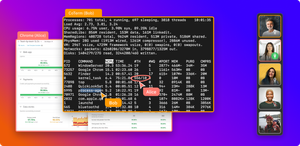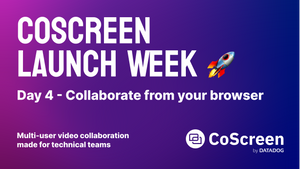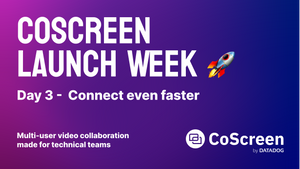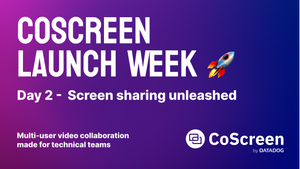John Lilly is a former CEO of Mozilla, an early investor of both Figma and Dropbox, a former partner at Greylock Partners, and an angel investor in CoScreen. This post is based on a discussion between John and the co-founders of CoScreen, Max Andaker and Till Pieper, as part of their Deep Collaboration Podcast.
Introduction
I grew up in a technical household -- my dad was an engineer, and my mom’s whole family was as well -- so no surprise that I went to Stanford University to study computer science. At Stanford, I was introduced to the importance of user experience work, back in the early '90s when user experience was being defined with the internet era. My favorite thing about the internet was how it made it so easy to do things together. At that time, it was revolutionary!
My master's degree was centered on user experience design, and I had the opportunity to work with pioneers in the industry like Terry Winograd and David Kelley.
On investing in collaboration and productivity tools
I tend to like two types of companies: tools for creatives like Tumblr or Instagram; and productivity systems, things like Dropbox, Quip and now Figma.
My first meetings with Figma were good, but I didn’t understand the business angle -- but the founders were so compelling that I kept getting drawn back in. After their seed round, Dylan Field (Figma co-founder & CEO) and I talked a lot, I got the opportunity to get involved at the Series A -- as Dylan and Evan were thinking about how to create a collaboration system for designers.
As an investor, I am looking for the ambition behind the product. What is the bigger picture? How will the founders take the company and product to the next level? At Figma, for example, the team had a bigger mission - they wanted to help designers build things better together, and enable asynchronous collaboration workflows, which wasn’t really possible previously.
This was different from Adobe's idea, which was the most prominent player in the market.
On developer collaboration
I think source code control software like GitHub and GitLab opened the door to collaboration for developers, but it's only the beginning.
Git-based workflows enabled engineers and developers to write code together efficiently for the first time and has transformed the way we create software today. But not a lot of innovation and progress has happened since then in the world of developer collaboration tools.
Folks are understandably worried that collaboration will interfere with their work. However, collaboration is here to help you be more productive and build software faster and better.
Collaboration is key for successful software development.
Engineering teams are becoming more collaboration-oriented, but it’s taking time and tools. In the early days at Figma, one of the biggest challenges we faced was convincing designers to share what they are working on while it was work-in progress. Now Figma is the leading tool for designers and has shifted the way designers work for the better.
We are faced with the opportunity to create all of our work products together remotely, which means stepping up and accepting collaboration and virtual systems like CoScreen.
If I am starting a company today, all I need is a little bit of Asana, a little bit of Slack, a little bit of Figma, and a little bit of CoScreen, then I am good to go!
Collaboration technologies and capabilities had improved tremendously since the early days of Google Docs when they were terrible at word processing but great for collaboration. We have come a long way since then, and it's time people will start taking notice.
Collaboration works because you allow your team to join you when solving a problem, making it a team effort, even for engineers it is best to work in a team. Collaborative coding is in its early days but has increased significantly since COVID-19 has accelerated remote working and the future of work as we know it.
As human beings, we are collaborative by nature, and the pandemic highlights that we need to find new ways to collaborate. We are forced to take all the things we create together and find a way for them to be collaborative, even in a remote setting.
With the rise of AWS, you have systems running all over the place, therefore developing is not just about code and the files that we create internally. It's more of a mix between the stuff that I am creating and the code that I am running at the same time, understanding the interactions and flow between systems. By definition, this is a multi-window and multi-system type of collaboration.
Remote leaders of tomorrow
Back in 2005, when I worked at Mozilla, we were mostly a distributed team. We only had IRC as a chat tool for what we use Slack for today. The question is what happens next with remote collaboration and which tools persist in helping us during this time.
Currently, I teach a class at the business school at Stanford University. One of my recent courses was about remote work. We were talking about the evolution of remote working and how it has changed during the last year. The students this year, compared to past years, showed a level of sophistication and understanding of asynchronous and synchronous communication and tools that is beyond what I imagined or anticipated.
Those are the leaders of tomorrow, the leaders that understand and deal with the new reality better than anyone. Remote collaboration comes naturally to them, and they will be discerning and demanding of their remote tools.
In my opinion, the tools that will provide and enable the most lightweight but high fidelity, high-velocity collaboration will be the tools that persist and become rooted as the standard toolset for the future of work.
We will see a spike in remote native tools platforms and innovation coming next to win the next generation of leaders. This is a massive opportunity for Figma, CoScreen, and tools alike to shine. With that said, many companies and technologies will fail to manage and provide such experience that new users seek.
Zoom vs. Deep Collaboration
The dominance of Zoom and similar tools in the remote space made me seek more collaborative solutions like CoScreen, out of necessity for tools beyond just pixels on a screen with audio. We need more, and we should demand more if this is how the future of work will pan out.
Don't get me wrong, Zoom is incredible. They’ve scaled tremendously well into a 100 Billion dollar company. They have been a vital part of our lives. My kids are in school on Zoom. You can have your issues with it, but we wouldn't have survived this year without it. Company meetings, family gatherings, and school were all made possible thanks to Zoom. But, when it comes to working and getting things done, it's a shallow collaboration, and it is not semantic at all!
At this point, the main thing that Zoom can do for us is not to fail - Zoom transmits video and audio but nothing on a deeper level. You can't really connect on tools like Zoom to better understand what my team is working on or solving issues together. Collaboration requires impact and labor together. Even though talking is a huge part of collaborating and an important part, it's just the beginning.
We are going to see more tools and systems that understand at a deeper level what we are working on, and at last, tools will be able to help and support us better.
The next generation of collaboration tools
The next generation of tools will help and enable us in a higher abstraction level of collaboration, and thanks to WebRTC, we will start to see video tools situated in environments that are contextualized with the environments that they are in, which will allow for video collaboration to be in the context. We are very early in the remote world, where the only thing we expect from our tooling is video and chat.
It is nice to see your teammate and their facial expression, but once COVID is a thing of the past, we are going to focus less on seeing our colleagues' faces and facial expressions, and priority will shift towards more on the work and how we do things together remotely. The next tools will be pivotal to the capabilities that we demand from the tools that will structure the future of work for years.
I think there is a more significant discussion to make about what enterprise collaboration is and what it is missing in the collaboration space. As much as I love to hypothesize on what is next for the future of work collaboration, we will have to wait and see.
Listen to our full conversation with John Lilly in the “Generation Remote” episode of our Deep Collaboration Podcast.
- Learn more about Deep Collaboration
- Learn more about CoScreen






